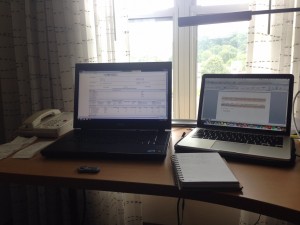All Monsanto Field Sales interns have a corporate project to complete as the final portion of their internship. These range from agronomy to marketing to brand assessment to data collection, etc. My group of five young women from different universities was assigned to work with the Monsanto brand Vistive Gold. Before describing the project, a brief history of the product is essential to understanding the purpose.
Vistive soybeans were designed to be high-oleic, meaning a lower amount of trans fat and saturated fat with the primary intent of reduce hydrogenated oils used in cooking and the food industry, leading to a healthier overall product. However, the first phases of the product (Vistive I-III) either never made it to the market or were not found desirable by the producers, noting a considerable yield drag. After revamping the product, Monsanto came out with Vistive Gold. Before pushing growers to produce it in large quantities, the company needed to do research to see where it would logistically make the most sense to push production. This is where our group came it.
Assigned over eight hundred different seed dealers across Ohio and Illinois under national brands (Asgrow & Dekalb), my job for the first eight weeks of the summer was to call my given dealer network to understand the grain handling capacities of each business. If the business had an elevator or grain storage system with their seed facility, I would then ask them about the size of their storage and their ability to handle specialty grains, as Vistive Gold soybeans would have to be handled as such. All of this data was recorded into a program called Salesforce, which then could be digitally analyzed and mapped out to get an idea of the distances from shipping facilities to storage sites.
While this process seemed tedious at first, it went quickly after the first few weeks. Collecting the data could be done at any time, and I would often then enter the numbers into Salesforce at the end of the day when I got back to my apartment. Towards the middle of July I began the data analysis portion of the project, looking into different factors such as Monsanto sales percentage in the region as well as grain facility capacity, preferences, and transportation methods. All of this was written into a final presentation that would be given at the end of the summer to my advisor board as well as a special Vistive Gold team.
As much as calling seed dealers to survey them sounds simple, there was often complication in the process. Many times seed dealers just wouldn’t answer, or rarely I would call a seed dealer who would not want to answer my questions because they felt it was invasive even though they were still a part of the Monsanto network. I even had one particular person on the phone that became very verbally upset that information was none of my business. Those situations were often uncomfortable to deal with, but also not unmanageable. I usually patiently listened to what they had to say, apologized for the inconvenience, and thanked them for their time. As infrequently as these occurrences happened, they were still standout, and it really helped me to understand the importance of a personal connection in sales – even if it is just a survey. The overall project itself though gave me a new perspective on developing a product, looking at the importance of logistics before planning the marketing mix.


